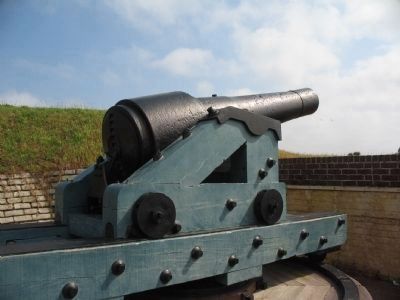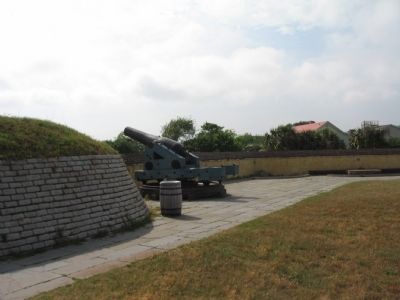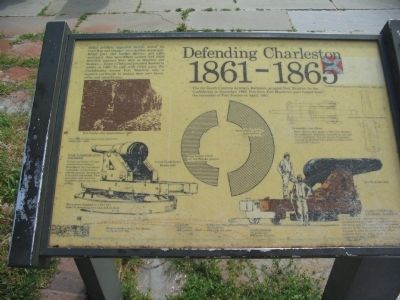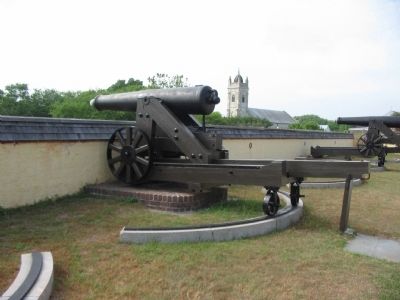Sullivans Island in Charleston County, South Carolina — The American South (South Atlantic)
Defending Charleston 1861-1865
Rifled artillery appeared shortly before the Civil War and changed coast defense drastically. Rifled guns shot harder, farther, and more accurately than smoothbore cannon and could demolish masonry forts such as Moultrie and Sumter - Union rifled guns pounded Sumter to rubble in 1863. To cope with rifled guns, the Confederates turned Fort Moultrie into a massive earthwork to protect their own heavy rifles and smoothbores.
Civil War artillery were aimed with simple open sights.
8-inch Columbiad rifled and banded
To meet the threat of Union ironclad fleets, General Beauregard, the Confederate commander in Charleston ordered captured smoothbores to be rifled and banded. These guns fired solid iron bolts intended to pierce the armor plating.
One cannon mounted in a fort was equal to several cannon mounted on ships.
32-pounder smoothbore
When the Civil War began in 1861, Fort Moultrie was armed with 32-pounder smoothbores and light 8-inch columbiads. You can see two 32-pounders mounted on Mordecai front pintle carriages which allowed 180° rotation.
10-inch Confederate Columbiad Smoothbore
In an age where rifled artillery was not considered totally perfected, smoothbore guns were still being used. (Remainder of text illegible)
Range of artillery used at Fort Moultrie during the Civil War.
32-pounder
32 pound shot
1900 yards (1.1 miles)
8-inch Columbiad Rifled and Banded
157 pound bolt
4000 yards (2.3 miles)
10-inch Columbiad
123 pound shot
5600 yards (3.2 miles)
Topics. This historical marker is listed in these topic lists: Forts and Castles • War, US Civil. A significant historical month for this entry is April 1861.
Location. 32° 45.556′ N, 79° 51.496′ W. Marker is on Sullivans Island, South Carolina, in Charleston County. Marker can be reached from Middle Street, on the right when traveling east. Located at tour stop 4 in Fort Moultrie National Monument. Touch for map. Marker is in this post office area: Sullivans Island SC 29482, United States of America. Touch for directions.
Other nearby markers. At least 8 other markers are within walking distance of this marker. Move a 50,000 pound Rodman Gun (a few steps from this marker); Enlisted Men's Barracks (within shouting distance of this marker); Harbor Defense (within shouting distance of this marker); Harbor Defense 1809-1860 (within shouting distance of this marker); Traverse c.1820 (within shouting distance of this marker); Powder Magazine (within shouting distance of this marker); Building Forts (within shouting distance of this marker); Fort Moultrie II (within shouting distance of this marker). Touch for a list and map of all markers in Sullivans Island.
Also see . . . Fort Moultrie. National Park Service site for Fort Moultrie. (Submitted on June 16, 2010, by Craig Swain of Leesburg, Virginia.)

Photographed By Craig Swain, May 3, 2010
3. 8-inch Columbiad, Banded and Rifled
This 8-inch Columbiad was originally cast by West Point Foundry, New York in 1857. The weapon as probably among the armament of Fort Sumter or Moultrie at the start of the war. General Beauregard ordered this piece, along with several others, to be rifled. An iron band was added over the breech to compensate for the higher pressures accompanied with rifled projectiles.

Photographed By Craig Swain, May 3, 2010
4. 10-inch Confederate Columbiad
Tredegar Iron Works in Richmond, Virginia produced this columbiad in 1862. While the profile resembles that of the Federal Rodman guns, to include the "mushroom" knob and bottle shape, Tredegar did not use the same cooling technique.
Credits. This page was last revised on June 16, 2016. It was originally submitted on June 16, 2010, by Craig Swain of Leesburg, Virginia. This page has been viewed 952 times since then and 28 times this year. Photos: 1, 2, 3, 4, 5. submitted on June 16, 2010, by Craig Swain of Leesburg, Virginia.


